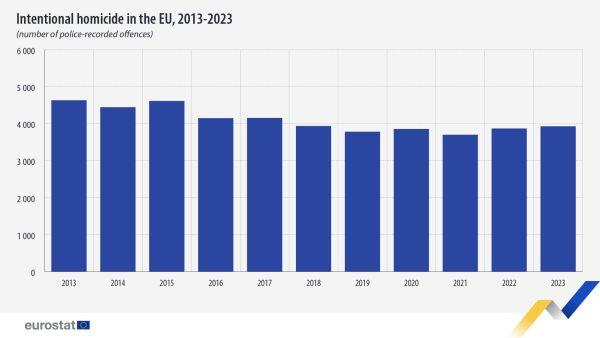In 2025, law enforcement agencies across France continue to grapple with a diverse range of crimes and offenses, reflecting shifting social dynamics and emerging challenges. Recent data from Statista offers a comprehensive breakdown of the types of criminal activities reported to the police nationwide, providing valuable insights into trends and areas of concern. From property crimes and violent offenses to cybercrime and drug-related incidents, the statistics shed light on the evolving landscape of public safety in France. This article delves into the detailed figures, exploring how different categories of crime have developed over the year and what they reveal about security priorities for authorities and communities alike.
Crime Trends in France 2025 Reveal Shifts in Offense Patterns
Recent data from law enforcement agencies in France illustrate a notable evolution in the landscape of criminal activity. While traditional street crimes such as theft and burglary have seen a modest decline, there is a marked uptick in digital and cyber offenses. Incidents involving online fraud, identity theft, and cyber harassment now constitute a significant portion of police reports, reflecting the growing influence of technology in everyday life. Meanwhile, violent crimes, including assaults and homicides, have remained relatively stable but with localized increases in certain urban areas.
Key shifts in offence types reported to the police in 2025 include:
- Rise in cybercrime cases by 15% compared to the previous year
- Decrease of 10% in residential burglaries nationwide
- Consistent numbers in violent crime, with notable spikes in select metropolitan zones
- Emergence of new crime categories linked to environmental violations and digital piracy
| Crime Type | 2024 Reports | 2025 Reports | Change (%) |
|---|---|---|---|
| Thefts | 250,000 | 230,000 | -8% |
| Cybercrime | 35,000 | 40,250 | +15% |
| Violent Assaults | 95,000 | 96,000 | +1% |
| Environmental Violations | 4,500 | 5,200 | +16% |
Detailed Breakdown of Violent and Nonviolent Crimes Reported to Authorities
When analyzing crime statistics in France for 2025, a clear distinction emerges between violent and nonviolent offenses, each displaying unique patterns and trends. Violent crimes, encompassing offenses such as homicide, assault, and armed robbery, remain a primary concern for law enforcement agencies. Notably, aggravated assault cases saw a marginal increase compared to the previous year, reflecting ongoing challenges in urban centers. Additionally, incidents of sexual violence have prompted a nationwide policy response, leading to enhanced victim support systems and preventative measures.
On the other hand, nonviolent crimes—including property crimes, fraud, and drug-related offenses—constitute the majority of reported cases. Property theft and burglary continue to dominate this category, with a noticeable rise in cybercrime offenses affecting both individuals and businesses. The following table summarizes key statistics, providing a concise comparison between reported violent and nonviolent crimes in 2025:
| Crime Category | Reported Incidents | Year-on-Year Change |
|---|---|---|
| Violent Crimes | 42,500 | +3.2% |
| Assault | 18,200 | +4.5% |
| Sexual Violence | 7,300 | +2.9% |
| Nonviolent Crimes | 128,700 | +1.8% |
| Property Theft | 60,450 | +0.9% |
| Cybercrime | 15,620 | +7.4% |
Emerging Cybercrime Threats Challenge French Law Enforcement Strategies
French law enforcement agencies are grappling with a surge in technologically sophisticated cyber threats that have outpaced traditional crime-fighting methods. Phishing scams, ransomware attacks, and identity theft now constitute a significant portion of reported offenses, reflecting a rapid evolution in criminal tactics. The rise in cyber extortion cases has placed additional pressure on investigative resources, forcing authorities to seek advanced digital forensic capabilities and inter-agency cooperation at the European level.
Emerging patterns reveal an unsettling increase in offenses involving:
- Cryptocurrency fraud linked to money laundering networks
- Deepfake technology used for blackmail and misinformation campaigns
- IoT device exploitation targeting both individuals and critical infrastructure
| Cybercrime Type | Reported Cases (2025) | Percentage Growth (YoY) |
|---|---|---|
| Phishing & Social Engineering | 18,500 | 22% |
| Ransomware Attacks | 12,300 | 35% |
| Cryptocurrency Fraud | 7,800 | 40% |
| IoT Exploitation | 3,100 | 28% |
As cybercriminal enterprises grow more complex, the need for specialized units within French law enforcement becomes increasingly urgent. Strategies prioritizing public awareness and digital literacy campaigns are being supplemented by increases in budget allocations for cyber units, highlighting a systemic shift towards preemptive cybersecurity enforcement rather than reactive policing.
Policy Recommendations for Enhancing Crime Prevention and Public Safety
To effectively combat rising crime rates, authorities should prioritize community engagement initiatives alongside technological advancements. Strengthening neighborhood watch programs and fostering partnerships between local law enforcement and community leaders can increase trust and enhance early crime detection. Additionally, investing in predictive policing software, balanced with strict privacy safeguards, can help allocate resources more efficiently and anticipate hotspots for criminal activity.
Key strategies include:
- Expanding social services aimed at at-risk populations to address root causes of criminal behavior.
- Enhancing training programs for police officers focused on de-escalation techniques and cultural competence.
- Implementing real-time data sharing platforms for faster inter-agency collaboration.
| Recommendation | Expected Impact |
|---|---|
| Community Engagement | Improved trust and proactive crime reporting |
| Predictive Policing Tech | Resource optimization and targeted patrolling |
| Social Intervention Programs | Reduction in recidivism rates |
Wrapping Up
In conclusion, the detailed breakdown of crimes and offenses reported to the police in France in 2025 offers critical insights into the evolving landscape of public safety in the country. By understanding the specific categories and their prevalence, policymakers and law enforcement agencies are better equipped to allocate resources, implement targeted interventions, and enhance community protection. As France continues to address these challenges, ongoing analysis and transparent reporting remain vital to fostering a safer environment for all citizens.




